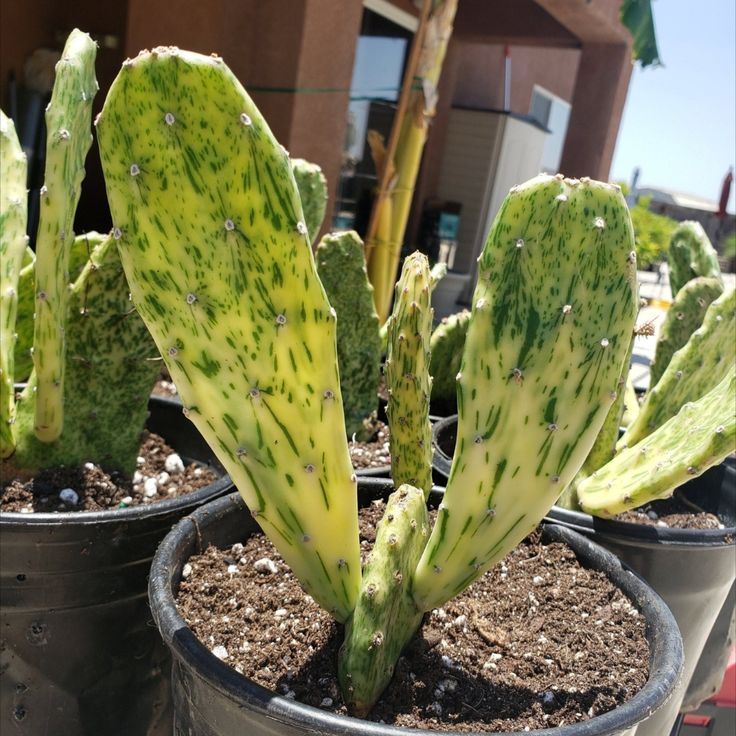Opuntia Sunburst

Opuntia sunburst
Opuntia cochenillifera are extremely drought tolerant, but enjoy a good amount of water during the summer growing season. Let the soil dry out between watering, but when you do water, water them thoroughly, fully saturating the soil. If you are unsure whether or not the soil is dry, wait a few days before watering.
How tall does Opuntia sunburst grow?
This plant's botanical name is 'Sunburst' and it grows up to 50 cm in height.
Is Opuntia the same as prickly pear?
Opuntia, commonly called prickly pear or pear cactus, is a genus of flowering plants in the cactus family Cactaceae. Prickly pears are also known as tuna (fruit), sabra, nopal (paddle, plural nopales) from the Nahuatl word nōpalli for the pads, or nostle, from the Nahuatl word nōchtli for the fruit; or paddle cactus.
How do you take care of Opuntia cactus?
Prickly pears are extremely drought tolerant. Don't water newly propagated pads for the first month. After that, water every two to four weeks for the first year — twice a month in summer and once a month other times of the year. In most areas, rainfall will be enough to sustain established plants.
Can prickly pear survive winter?
When growing a prickly pear cactus in a pot, make sure to bring it indoors during the winter. It should survive just fine in the typical atmosphere of a home during the wintertime. If the cacti are in the ground outside, protect them from the harshest cold with a generous layer of mulch around the bottom of the plant.
Can Opuntia cactus survive winter?
Prickly pear (opuntia) It thrives in sandy soil and seldom needs to be watered in the winter. It's hardy down to climate zone four, so it's a go-to for cacti enthusiasts who live in colder regions. Don't worry if the paddles look deflated—this is just a sign of winter dormancy.
Do prickly pear cactus need full sun?
Cultivation. Indoors prickly pears need a brightly lit position, preferably a south-facing or west-facing aspect or grown in a conservatory or heated greenhouse with good, all-round light. They need 4-6 hours of direct sunshine in summer.
Where do prickly pears grow best?
Prickly pear grows best in full sun and well-drained soil. Clay soil or slow-draining soil is problematic in cool regions where prickly pear will suffer in moist soil during the winter months. Both drought- and heat-tolerant, this long-lived succulent plant tolerates sandy, rocky soil, and seaside planting places.
Is Opuntia fast growing?
Opuntia cacti are fast-growing varieties, adding anywhere from two to eighty centimeters of new growth per year depending on their environmental conditions. You should make sure to plant them in a larger pot to accommodate their fast growth (and also to give the roots room to grow and expand).
Are all Opuntia fruits edible?
Prickly Pear (Opuntia) is a very flexible food source. Both the pads (nopales) and the fruit (tunas) are edible, but caution should be taken with both harvesting and preparation.
Can you eat Opuntia fruit?
The eastern prickly pear cactus (Opuntia humifusa) is native to the lower 48 states of the United States. It is not only a beautiful plant, but it is also edible, provides food and protection for wildlife and can be used in native landscaping.
Are Opuntia self pollinating?
Opuntia exhibit a variety of breeding systems—self-compatibility (autogamy), cross- pollination (xenogamy), apomixis (production of seeds without fertilization) (Mondragón & Pimienta 1995), cleistogamy (self-pollination before anthesis) (Rosas & Pimienta 1986).
What does an overwatered prickly pear look like?
Prickly pear turns yellow due to overwatering, insufficient sunlight, or pests. Prickly pear does not require much water, and excess water leads to root anoxia and root rot.
How often does a prickly pear cactus bloom?
Prickly pear is a native perennial cactus with large, showy yellow flowers that bloom in late spring and early summer.
How long do prickly pear cactus last?
They are known to live well over 20 years. There are several different varieties of prickly pear cactus each growing to different sizes. The most common species in the Sonoran Desert is the Engelmann prickly pear which grows up to 5 feet tall and can grow to a width of 10-15 feet.
How cold is too cold for prickly pear cactus?
Eastern prickly pear cactus (Opuntia humifusa) is a cold-hardy cactus native to the Eastern United States. It's hardy to zone 4 (-30 F), which means almost anyone can grow prickly pear fruits at home (even outside the desert).
How long does it take for a prickly pear cactus to bear fruit?
| Plant Type: | Herbaceous fruiting perennial | Flower/Foliage Color: |
|---|---|---|
| Bloom Time/Season: | Spring-summer | Soil Type: |
| Exposure: | Full sun | Soil pH: |
| Time to Maturity: | 3-4 years | Soil Drainage: |
| Planting Depth: | 1/8 inch (seeds), 2 inches (transplants) | Attracts: |
Is prickly pear invasive?
Invasive Features The wide-spreading, fibrous root system of prickly pear allows access to surface water, and its succulent stems store large quantities of water. During drought years, prickly pear usually spreads more readily than grasses, especially under hot, dry conditions.
Can I leave my cactus outside in the rain?
Many cactus species can survive the rain, even heavy and prolonged falls while others can rot very quickly when exposed to too much rain. A small sprinkle or being rained on for a day should, however, not kill any cactus.
What is the most cold tolerant cactus?
The most cold-hardy include Great Plains natives like Escobaria, the wide-ranging Opuntia, and mountain dwellers, such as Echinocereus and Pediocactus, which can withstand winters lows of -30°F and colder.













Post a Comment for "Opuntia Sunburst "